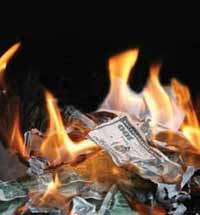The Economy: US and the World
"Madness is rare in individuals - but in groups, political parties, nations, and eras it's the rule." (Friedrich Wilhelm Nietzsche)

And no madness is worst than greed. Every so often people assume that somehow they can make money out of the thin air. The most famous one was the Tulip mania of 1636-1637 in Netherland and the most recent one was the “dotcom” bubble of 1995-2001 (on March 10th, 2000 the NASDAQ peaked at 5132.52). Today we are witnessing the beginning of the end of the real estate bubble.
In every case, the madness begins with those who have high tolerance for financial risk. That is to say they are rich and can afford greater financial loss than others. They speculate and make money, lots of money. Soon the less wealthy see this and join the crowd and before you know it the whole country is involved.
When President Bush entered office he gave one trillion dollars (tax cut) to the wealthy. In effect he increased the tolerance for financial risk of the wealthy individuals and companies even further. Later, he started the Iraq war, pouring billions of dollars into the economy. One should not forget that when the US government spends about $2 billion a week in Iraq, most of that money finds its way back into the US economy (salaries, armament, etc). But all these monies were borrowed money (deficit spending), and all the growth and feeling of well being was illusory.
The money pumped into the economy had to find some channel for investment. So banks and financial institutions began to push money in hope of getting incredible returns. Easy credit was the solution. You want to buy a house? No problem, we finance 90% of it. You want to have a new car? No problem, we give you a loan. This push suddenly made it possible for millions of people to buy houses, putting pressure on the housing market. House prices sky-rocketed, increasing the illusion of increasing wealth, which in turn allowed people to borrow more money. All the time, banks and credit institutions were jubilant at the sight of extraordinary returns on their investments. A normal credit company charges around 18% to 23% on the dollar while they borrow the same money for 8% to 9%. It is a great business. The banks also had a good time. Cheap money was lent to people backed by assets that were appreciating in value. The risks were spread by selling mortgages to other banks and institutions. Before you knew it every bank, insurance company and god knows who else were rushing in to take their piece of the action.
Growth in housing construction represents a substantial part of general US economic growth. So with easy credit and continuing increase in housing prices, US showed a good growth rate, giving the illusion of well-being.
But as with Tulips and DotComs manias, there comes a time when there is no more room for illusory growth and demand. The bubble bursts and asset prices crash. The banks are left with depreciating asset guarantees for their loans and before you know it the whole financial system is in trouble. Usually when this happens, it takes a few years for the companies and individuals involved to go bankrupt, after which the cycle starts anew. Hopefully with lessons learnt.
But this time it is different. When a recession starts, the government has a few tools at its disposal to deal with the economic downturn: Interest rate, the budget and war. It reduces interest rates to stimulate economic growth. It can also start large infrastructure projects such road building, constructing bridges etc, to reduce unemployment and stimulate the economy (deficit-spending). There is another sure way of kick starting the economy and that is WAR. Wars are good for businesses and reduce unemployment and stimulate (for US) important parts of the economy.
However, all three tools have been already used prior to the recent recession. UShas huge trade deficit and is involved in two wars (Afghanistan and Iraq). It has also reduced its tax revenues by giving huge tax-cuts to the rich. Large trade deficit, low tax revenue, tremendous debt, wars and low interest rates make it extremely difficult for the government to do much to help the economy.
If this was not enough its currency “the mighty dollar” is losing its position as the preferred international reserve and trading currency. The Federal Reserves keeps pumping dollars into the market, while at the same time keep reducing interest rates. This means only two things, a devaluation of dollar and an increasing inflation. Countries such as China, Japan, oil producing countries and others keep their reserves in dollar. These reserves are in the order of trillions of dollars. Imagine a 15% decline in value of dollar will translate to $150 billion dollar loss for the Chinese government alone. How long will these countries tolerate this loss is anyone’s guess, but surely there comes a time when these countries will react and begin to switch to other currencies. It is then that we will see the real collapse of the US economy.
There is already some ominous sign of this. A few days ago, Venezuela declared that it will no longer sell its oil in dollars. Currently there are Iran, Venezuela, and Russia that have decided to trade their oil and gas in other currencies. In addition, some Arab countries have started to de-peg their currencies from dollar. For these countries peg to dollar has meant importing inflation and they are trying to stabilise their economy. As dollar decreases in value and more and more raw-material producers switch away from dollar, this de-pegging will only increase.
Let us look at why this happens. China buys oil in Euro from Iran. It then produces gadgets and sells it in dollar. Naturally the dollar prices of Chinese goods increase. The US and others that use dollar or are pegged to dollar will see an increase in prices of their imports which is passed to the consumers. This means importing inflation. The countries that have pegged their currencies to the dollar naturally do not wish to import inflation and cut their loss. (Please note: raw materials in general are increasing in value, regardless of the currency. There is not enough space here to discuss this matter in detail)
This will put further pressure on the dollar contributing to its decline. This, of course is not good for the US consumers. When times were good (illusory) US kept its inflation in check by importing goods from countries such as China, India, and other places; where imports were paid with dollars. Now some stuff has to be paid for in Yen and Euro both of which are appreciating in value against the dollar. At the same time oil and gas prices have increased tremendously, not only in dollar term but also in other currencies. All these things mean that US has to pay many more dollars for the goods that it imports. In simple terms, US’ inflation is rising rapidly. In my opinion, the US government is not telling the American people the real truth, fearing further collapse in confidence.
The outlook for the US economy
When recession hits, the government usually starts deficit spending to increase employment. At the same time the interest rates are reduced to stimulate economic growth. United States is now in an unenviable position of entering recession with very low interest rates, huge deficit and declining dollar.
Already in August 2006 I warned about the coming financial crisis (please read “U.S. and The Coming Financial Crisis”). The following is an excerpt from that article: “The current account deficit of over 7 per cent has long passed its danger levels of 4-5 per cent. In 2005 the U.S. government paid $325 billion dollars only in interest payments alone. Then there are the future obligations such as Medicare, Social Security and government pensions. Theseobligations amount to $54 trillion dollars. This huge problem worried the former Federal Reserve Chairman Alan Greenspan. He told congress: “As a nation, we may have already made promises to coming generations of retirees that we will be unable to fulfil”
As can be seen the government has not the ability to meet its existing financial obligations to the American people, let alone starting infrastructure projects to reduce unemployment or help the economy.
With regards to the interest rates, the Federal Reserves has very little room for manoeuvre. Already the real interest rates are in negative territory (lower than inflation), although the government and the experts say otherwise. Further interest rate cuts will only increase inflation and devalues the shaky dollar even further. But this is exactly what the Federal Reserves is doing. This is most likely to rescue big financial institutions, the very institutions that were earning huge profits from unsuspecting American consumers. In effect, the Fed is abandoning the poor and helping the rich. If the government was serious in helping the working American, it would have paid the money directly to the people, so that they could pay their debt. Instead it is pouring hundreds of billions of dollars into the banks. If you count the monies that have been poured into the financial markets, you’ll see that $160-$200 billion dollar tax rebate to the people was only mere peanuts as compared to what banks and others have received.
All in all, one can say that this recession, if it doesn’t turn into a depression, will be severe and will last at least 2 to 4 years. Now you must realise that I am talking about the effects of the recession and not technical recession. The recent technical recessions that we have seen is listed below:
- January-July 1980: 6 months (worst quarter GDP Growth -7.8%)
- July 1981-November 1982: 16 months (worst quarter GDP Growth -6.4%)
- July 1990-March 1991: 8 months (worst quarter GDP Growth -3.0%)
- March 2001-November 2001: 8 months (worst quarter GDP Growth -1.4%)
Technically a recession may last one year, but the effect of that recession on families may last a decade. Some lose their homes, some their jobs, some families will break-up and so on and so forth. The human misery of technical recession lasts much longer than the recession itself. Anyway, if the price of the houses is dropped by 40% in two years, how many years of growth will it take to retake that 40%? Usually much longer than people think.
I wrote an article in September 2006 titled “Who Will Pay the US Debt”. In this article I explained who will be most affected by the coming financial crisis. This is the direct excerpt from that article:
“The truth is that at the end of the day it is the American people that have to pay. This will be in the form of higher taxes and reduced governmental services. In other words lower living standards. The poor and the working poor do not have anything to give. Their contribution will be in form of statistics. The number of people living below poverty line will increase. They will suffer because they rely on many services that will be cut or reduced. The rich will always find some loop-hole to avoid paying the major part of their share. Even if their wealth is reduced by 10%, they will see no hardship. This leaves us with the Middle class. This group will be hit the hardest. They will see their taxes and expenses increase simultaneously. A good portion will have to live on far less than they are used to. Many will work longer hours just to stay solvent. Many may also join the working poor. It all may sound rather apocalyptic but the numbers do not lie. Politicians may avoid this problem for now, but sooner or later someone has to pay the piper.”
By Dr. Abbas Bakhtiar
To be continued
Subscribe to Pravda.Ru Telegram channel, Facebook, RSS!




